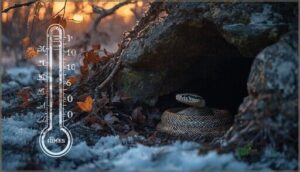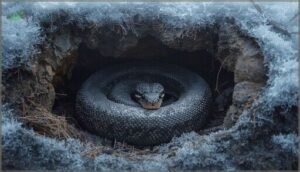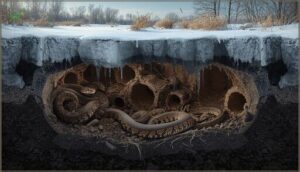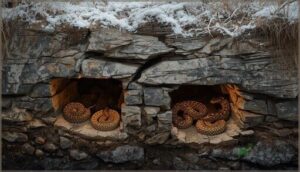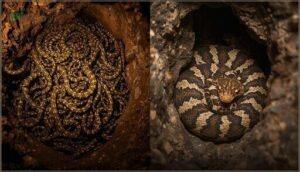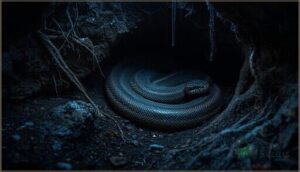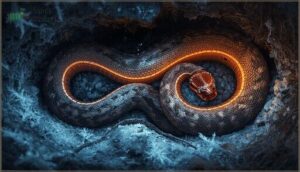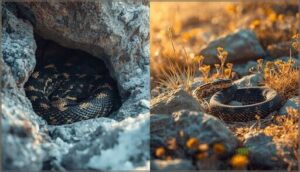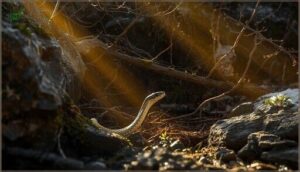This site is supported by our readers. We may earn a commission, at no cost to you, if you purchase through links.
You won’t find snakes basking on rocks or slithering through leaves once temperatures dip below 60°F. These cold-blooded creatures don’t have the luxury of generating their own body heat, so when autumn’s chill sets in, they face a simple choice: find shelter or freeze.
Most snakes in temperate climates retreat underground between September and November, though the exact timing depends on where you live and which species shares your habitat. This dormancy period—called brumation rather than true hibernation—can last anywhere from a few weeks to six months.
Understanding when snakes disappear and reappear helps you know what to expect throughout the year, whether you’re managing property, enjoying outdoor activities, or simply curious about these misunderstood reptiles.
Table Of Contents
- Key Takeaways
- What is Snake Hibernation?
- When Do Snakes Go Into Hibernation?
- What Triggers Snake Brumation?
- How Long Do Snakes Hibernate?
- Where Do Snakes Hibernate?
- How Do Snakes Behave During Hibernation?
- What Happens to Snake Physiology?
- Do All Snake Species Hibernate?
- How Do Geographic Factors Affect Hibernation?
- When Do Snakes Emerge From Hibernation?
- Frequently Asked Questions (FAQs)
- At what temperature do snakes become inactive?
- What month do snakes go away?
- How do you know if a snake is hibernating?
- What month do snakes brumate?
- Where do snakes go during the winter?
- What is the best time of day to avoid snakes?
- Do snakes hibernate in houses?
- Do snakes hibernate?
- When do rattlesnakes hibernate?
- When do grass snakes hibernate?
- Conclusion
Key Takeaways
- Snakes enter brumation (not true hibernation) when temperatures consistently drop below 60°F, typically between September and November in temperate climates, with dormancy lasting anywhere from a few weeks in southern regions to six to eight months in northern areas.
- During brumation, snakes drastically slow their metabolism and heart rate while occasionally waking on warm days to drink water or bask in sunlight, unlike mammals that remain in deep, uninterrupted sleep throughout hibernation.
- Snakes choose hibernation sites like underground dens (hibernacula), rock crevices, and burrows that stay below the frost line, with some species gathering communally in shared dens while others prefer solitary shelter.
- Geographic factors—including latitude, elevation, and local climate—determine both the timing and duration of brumation, with high-altitude and northern snakes hibernating significantly longer than their southern or low-elevation counterparts.
What is Snake Hibernation?
When winter approaches, snakes don’t curl up for a long nap the way bears do. Instead, they enter a state called brumation—a cold-blooded cousin to hibernation that works differently but fulfills the same survival purpose.
Unlike bears, snakes enter brumation—a cold-blooded survival state that serves the same winter purpose as hibernation
Understanding what this process really involves helps you recognize why snakes disappear when temperatures drop and what’s actually happening to their bodies during those quiet months.
Brumation Vs. True Hibernation
What sets snake hibernation apart from the deep sleep of bears? You’ll find the key difference lies in brumation—a distinct form of dormancy for cold-blooded reptiles. Unlike true hibernation in mammals, brumation allows snakes to:
- Wake periodically to drink water and bask on warm days
- Experience less dramatic metabolic rates reduction
- Maintain some environmental responsiveness throughout winter
This cold adaptation reflects reptile behavior shaped by ectothermic physiology rather than the profound energy conservation seen in hibernacula-dwelling mammals. Snakes enter a state of cold blooded brumation to conserve energy during winter.
Cold-Blooded Adaptations
As a cold-blooded animal, your snake can’t generate its own body heat—it depends entirely on external temperatures for thermal regulation. When winter arrives, this physiological response triggers a metabolic slowdown, with oxygen consumption dropping dramatically as ambient temperatures fall.
You’ll notice darker-scaled snakes absorb sunlight faster, a cold adaptation that’s vital in high-altitude environments where every degree matters for survival. Snakes often prepare for this period by seeking out suitable winter hibernation locations.
Purpose of Dormancy
This metabolic slowdown isn’t random—it’s a strategic survival mechanism. Dormancy allows snakes to conserve energy when food becomes scarce and conditions turn hostile. Here’s what brumation accomplishes:
- Reduces metabolic rates to minimal levels
- Prevents fatal hypothermia during temperature drops
- Preserves stored fat reserves throughout winter
- Synchronizes reproductive cycles with spring emergence
Without this physiological adaptation, your snake wouldn’t survive harsh winters.
When Do Snakes Go Into Hibernation?
The timing of snake brumation isn’t one-size-fits-all—it shifts dramatically based on where a snake lives and what the local climate throws its way. Temperature drops and seasonal shifts act as natural alarm clocks, signaling when it’s time to seek shelter.
Let’s break down how location, weather patterns, and the calendar itself shape when snakes disappear underground.
Seasonal Timing by Region
You’ll notice regional patterns shape when snakes settle into their hibernation period. In northern U.S. and Canada, most species retreat by September or October, staying dormant through March or April—sometimes six to eight months in cold climates.
Southern populations may skip winter months entirely, while European and Australian snakes follow their own seasonal cycles. Geographic variations tied to climate zones mean timing shifts dramatically with latitude and altitude.
Climate and Temperature Cues
Temperature fluctuations serve as your most reliable signal that snakes will enter brumation. When ambient readings consistently drop below 60°F for roughly two weeks, cold-blooded reptiles respond to these thermal cues by seeking underground shelter.
Climate shifts across geographic variations dictate whether winter patterns last weeks or stretch through entire winter months in cold climates, with hibernation timing tied directly to local temperature range stability.
Month-to-Month Variation
Across temperate regions, you’ll witness dramatic seasonal shifts in snake hibernation patterns from month to month. September brings early preparation as nighttime temperatures dip below 60°F, while October marks peak den entry for most species. By November through February, snakes remain dormant underground, and March triggers widespread emergence as climate influences reverse and temperatures climb.
- September–October: Initial brumation responses and peak underground migration
- November–February: Full dormancy with minimal surface activity
- March: Spring emergence driven by warming temperature fluctuations
What Triggers Snake Brumation?
Snakes don’t just pick a random day to shut down for winter. Their bodies respond to specific environmental signals that tell them it’s time to conserve energy and find shelter.
Three main factors work together to flip that biological switch: dropping temperatures, shorter days, and dwindling resources.
Temperature Thresholds (e.g., 60°F)
When does the chill in the air become too much for a snake? Most species shift into brumation once temperatures consistently drop below 60°F. At that threshold, their cold-blooded bodies can’t sustain normal activity.
Here’s how thermal limits guide dormancy cues:
| Temperature Range | Snake Response |
|---|---|
| Above 60°F | Active, hunting, basking |
| 40–60°F | Brumation thresholds reached; metabolism slows |
| Below 40°F | Deep dormancy; survival mode engaged |
Temperature fluctuations signal it’s time to retreat underground.
Changes in Daylight
Daylight itself acts as a silent alarm clock for snakes preparing to brumate. As photoperiod effects become pronounced in fall, snakes respond to shrinking daylight hours—often below 11 hours per day—by cutting activity by up to 85%.
These seasonal adaptation signals trigger brumation weeks before cold truly arrives, syncing populations at communal dens and initiating the metabolic slowdown essential for surviving winter months.
Food and Water Scarcity
When prey disappears, brumation becomes a lifeline. Drought impacts can slash small-mammal abundance by 50%, triggering starvation effects that push snake hibernation timing earlier.
During winter months, snakes adapt by lowering metabolic demands up to 72%—essential energy conservation when food vanishes. Water conservation matters too; even semipermanent wetlands dry up, limiting hydration.
These nutrient deficiency pressures make brumation less about cold and more about surviving resource scarcity through strategic animal adaptation and prey availability tracking.
How Long Do Snakes Hibernate?
The length of brumation varies widely depending on where a snake lives and how harsh the winter gets. Some species stay dormant for just a few months, while others remain tucked away for half the year or more.
Let’s look at how climate, species, and weather extremes shape hibernation duration.
Duration by Climate Zone
Your location determines how long snakes stay dormant. In northern climates, brumation stretches five to eight months—September through April—while subtropical zones see just two to eight weeks of inactivity. High-elevation snakes face extended dormancy compared to lowland populations at similar latitudes.
Climate warming has shortened these hibernation periods by up to several weeks, reshaping winter survival strategies and seasonal shifts across regional patterns.
Species-Specific Dormancy Periods
Each species follows its own dormancy patterns. Eastern garter snakes hibernate four to six months, while copperheads stay dormant for just three to five months depending on latitude. Ball pythons from tropical regions rarely brumate at all—they might pause feeding for two to four weeks, but deep hibernation cues don’t trigger winter survival responses.
These species variations reflect how evolution shaped reptile behavior and physiology to local climate demands.
Impact of Weather Extremes
Beyond species-specific patterns, weather patterns and climate change now disrupt traditional dormancy cycles. Extreme temperatures push snakes into unfamiliar survival strategies:
- Heatwaves trigger early emergence – Each 1°C rise correlates with 6% more surface activity
- Rain replaces protective snow – Winter survival drops without 15 cm insulation
- Cold snaps increase mortality – Inadequate hibernacula expose snakes to ecosystem disruption
These wildlife biology shifts alter animal physiology and ecological adaptations across temperate zones.
Where Do Snakes Hibernate?
Finding the right winter shelter can mean the difference between life and death for a snake. When temperatures drop, snakes seek out specific locations that offer protection from freezing conditions and predators. Let’s look at the most common places where snakes spend their dormant months.
Underground Dens and Hibernacula
When winter sets in, you’ll find snakes retreating into underground dens called hibernacula—elaborate tunnel systems that offer essential burrow insulation below the frost line.
These subsurface structures average 79 cm deep and contain multiple chambers connected by over six meters of tunnels. Den architecture matters: deeper hibernacula maintain stable temperatures around 5–6°C, protecting snakes during brumation when surface conditions would otherwise prove fatal.
Rock Crevices and Burrows
You’ll find rocky outcrops and deep crevices serving as critical winter denning sites. About 53% of timber rattlesnakes brumate in rock formations rather than other underground shelters.
These natural caves maintain temperatures 1–1.5°C warmer than surface levels, with burrow depth averaging 0.8–1.5 meters below ground. Rock crevices provide enhanced insulation—survival rates exceed 90% compared to just 70% in exposed hibernacula during severe cold snaps.
Communal Vs. Solitary Sites
Snake sociality shapes hibernation strategies in striking ways. Garter snakes pack into communal hibernacula—thousands clustering together—while 76% of Great Basin gophersnakes prefer solitary dens.
Timber rattlesnakes show 100% fidelity to shared sites, returning within a meter of last year’s entrance.
Ball pythons spend 61% of dormancy time grouped, benefiting from shared warmth as shelter duration increases with den occupancy.
How Do Snakes Behave During Hibernation?
Once a snake settles into its den, its behavior shifts dramatically from the active months. You won’t see much hunting or roaming—most of the time, they’re motionless and tucked away.
Here’s what actually happens during those long, cold months underground.
Reduced Activity and Movement
During brumation, you’ll notice snakes become strikingly still—think of a pause button on their usual movements. Radio telemetry studies show large relocations over 20 meters become rare after they settle into dormancy patterns.
This lethargy period reflects extreme energy conservation through movement reduction, as snakes retreat into subterranean behavior with minimal surface activity throughout hibernation.
Occasional Emergence on Warm Days
Even though snakes mostly stay dormant, you might spot them basking when temperatures climb above 10°C (50°F) during a winter warm spell. These brief Warm Day Activity episodes showcase flexible Snake Wintering Habits, allowing essential Thermal Gain through sunlight exposure.
Studies reveal timber rattlesnakes emerge mid-winter with distinctive Emergence Patterns:
- Surface basking averaging 5.3 hours per event
- Body temperature increases up to 26.5°C
- Multiple emergence bouts—sometimes ten times per season
This strategic snake hibernation behavior bolsters immune function and reduces infection risk during brumation’s Cold Snap challenges.
Absence of Feeding and Digestion
During brumation, you won’t see any feeding activity—the snake’s digestive system basically powers down. Gut Atrophy occurs as organs shrink by up to 50%, while Metabolic Suppression cuts energy needs by 70%. This Digestive Shutdown allows snakes to survive months of Fasting Adaptations without food.
Once spring arrives, Reversibility Mechanisms restore full digestive function within days of that first meal.
What Happens to Snake Physiology?
When temperatures drop, your snake’s body shifts into survival mode. Its internal systems slow down dramatically to conserve every ounce of energy through the coldest months.
Here’s what actually happens beneath the surface during brumation.
Slowed Heart Rate and Metabolism
When you think about a snake shutting down for winter, imagine its body shifting into extreme slow motion. During brumation, physiological adaptation becomes the focal point—heart rate reduction drops beats per minute to nearly zero, while metabolic suppression cuts energy use drastically.
Here’s what happens inside a dormant state:
- Heart rates plummet from active levels to just a few beats per minute
- Metabolism slowdown eliminates digestion and muscular activity entirely
- Energy conservation relies on stored fats and glucose mobilization
- Temperature regulation becomes entirely dependent on external conditions
- Reptile brumation allows survival through months without food
This hibernation strategy is pure efficiency.
Body Temperature Regulation
Unlike warm-blooded animals, you won’t find snakes generating their own heat during winter. Their ectothermic regulation means body temperature mirrors the environment—ranging from near-freezing to mild depending on den conditions. This thermal adaptation is critical for cold resistance.
Snakes rely entirely on thermoregulation through behavioral choices: basking on warm days, retreating underground for heat conservation, and minimizing temperature fluctuation inside stable hibernacula to survive brumation safely.
Hydration During Dormancy
While body temperature drops, water balance remains essential for dormant physiology. Cold-blooded animals can’t risk complete dehydration, so hibernacula near moisture sources support survival.
Snakes in brumation occasionally emerge to drink or soak, absorbing hydration through their skin. Snake hibernation patterns show that reptile brumation behavior includes seeking water on milder days—these hydration cues help maintain cellular function without feeding throughout winter dormancy.
Do All Snake Species Hibernate?
Not every snake retreats underground when temperatures drop. Whether a species brumates depends almost entirely on where it lives and what conditions it evolved to handle.
Let’s look at which snakes hunker down for winter and which stay active year-round.
Temperate Vs. Tropical Species
Not all snakes shut down for winter—it depends on where they live. Climate zones shape survival strategies dramatically. Temperate snakes must brumate for 4-6 months when temperatures drop, while tropical snakes stay active year-round or take brief breaks during dry spells.
- Temperate species retreat underground when frost threatens
- Tropical species rarely need dormancy—warmth sustains them
- Geographic variance determines hibernation patterns entirely
- Species adaptation reflects local temperature and rainfall cycles
Understanding these dormancy patterns helps you predict snake behavior in your region.
Examples: Garter, Copperhead, Grass Snakes
Let’s look at three common temperate snakes and how their hibernation patterns differ. Each species adapts brumation timing to local conditions, but their strategies reveal important behavioral differences.
| Species | Hibernation Period | Duration | Temperature Trigger | Habitat Preference |
|---|---|---|---|---|
| Garter Snake | September–April | 6–8 months | Below 60°F (16°C) | Communal dens, burrows |
| Copperhead | October–March | 4–5 months | Declining fall temps | Shared rocky hibernacula |
| Grass Snake | November–March | 4–5 months | Cold autumn onset | Underground shelters |
Garter snakes enter brumation earliest, sometimes by September in northern regions, and often gather in large communal dens with hundreds of individuals. They share underground burrows below the frost line, where temperatures remain stable. During dormancy, their diet shifts completely; they stop feeding and rely on stored fat reserves.
Copperheads exhibit different behavior. These venomous snakes brumate later, typically starting in October or November. They return to the same rocky dens year after year, sometimes sharing space with other species. While less social than garter snakes, they still prefer communal sites.
Grass snakes, common across Europe, brumate from late fall through early spring. They choose habitats like compost heaps and rotting vegetation, which provide insulation. They emerge in March or April when temperatures rise, immediately seeking mates.
All three species demonstrate classic snake hibernation: slowed metabolism, no feeding, and occasional warm-day basking. Understanding these patterns helps you anticipate when you might encounter these snakes near your property.
Species With No Dormancy
Not every snake needs to shut down for winter. Tropical species like green tree pythons and many boas remain active year-round in consistently warm climates. Equatorial snakes face no brumation because temperatures stay stable.
Desert adaptations also differ—sidewinder rattlesnakes may rest briefly during cold snaps but skip prolonged dormancy. In warm climates where prey stays abundant, hibernation simply isn’t necessary for survival.
How Do Geographic Factors Affect Hibernation?
Where a snake lives shapes everything about its winter rest. A garter snake in Manitoba faces a completely different set of conditions than one basking in the mountains of Bulgaria or the Mediterranean coast.
Let’s look at how climate, elevation, and local habitat dictate when snakes disappear and how long they stay gone.
Northern Vs. Southern Climates
Where you live shapes everything about how snakes handle winter. Northern snakes face a marathon of dormancy—seven to eight months underground when temperatures plummet—while their southern cousins might brumate just a few weeks or skip it entirely during mild years.
Here’s how climate zones reshape snake hibernation:
- Northern regions trigger brumation around 60°F in September or October
- Southern snakes remain semi-active on warm winter days
- Duration varies from one month in warmer areas to eight months up north
- Temperature gradients drive regional adaptation and dormancy patterns
- Geographic variance means some species never truly enter deep brumation
High Vs. Low Elevations
Altitude rewrites the rules of winter ecology. At high elevations, snakes brumate longer—often September through April—as temperature gradients create harsher conditions and shorter growing seasons. Lower down, dormancy lasts only weeks or is skipped entirely. Geographic variance matters: elevation effects drive when snakes enter hibernation, how deeply they rest, and when spring finally pulls them back to the surface.
| Elevation | Brumation Duration | Temperature Threshold |
|---|---|---|
| High Altitude | 6–8 months (Sept–April) | Cooler, earlier onset |
| Low Elevation | 1–3 months or none | Milder, later onset (~60°F) |
| Mid-Range | 3–5 months variable | Moderate, site-dependent |
Local Habitat Influence
Beyond elevation, microclimate effects and habitat selection reshape brumation at ground level. Snakes pick hibernacula—dens, caves, burrows—based on thermal refugia, moisture, and burrow stability.
South-facing slopes, rock crevices below the frost line, and moist soil create pockets where snake species and habitats align perfectly. Local features can shift timing by weeks, proving that elevation factors alone don’t tell the whole story.
When Do Snakes Emerge From Hibernation?
Snakes don’t emerge from hibernation on a set date—they respond to rising temperatures and longer daylight hours as winter loosens its grip.
Most temperate species begin to stir when soil temperatures climb above 50°F and spring sunshine warms their hibernacula.
Understanding these emergence patterns helps you anticipate when you’ll start seeing snakes active in your area again.
Spring Temperature Signals
You’ll notice snakes emerging from brumation when daytime temperatures consistently reach about 60°F (15.5°C). These thermal cues trigger snake behavior as their ectothermic regulation depends on external warmth.
Spring emergence timing varies by climate signals—warmer southern regions see activity weeks earlier than northern populations. Temperature thresholds around 58-62°F initiate dormancy triggers reversal, while photoperiod reinforces thermoregulation readiness after hibernation ends.
Post-Brumation Behavior
When snakes first emerge, you’ll see them basking near their dens for two to three days—a critical phase for thermal regulation. Their heart rates climb from 5% of normal levels as they warm up.
Watch for these key post-brumation behavior patterns:
- Delayed feeding until digestive systems reactivate after months of shutdown
- Social gatherings for mating and territory establishment
- Gradual movement expansion from den to wider hunting grounds
Risks and Survival Challenges
Emerging too early can be deadly. Juvenile snakes face mortality rates up to 21% during hibernation and brumation periods, while some species like the Great Basin rattlesnake show rates between 34% and 50%.
Predation risks from weasels and hawks intensify during emergence, alongside physiological challenges like dehydration threats and suppressed immune systems—critical environmental stress factors in cold-weather animal behavior and wildlife survival strategies.
Frequently Asked Questions (FAQs)
At what temperature do snakes become inactive?
When autumn’s chill settles in, coldblooded animals like snakes respond instinctively to temperature thresholds. You’ll notice snakes become inactive around 60°F, triggering brumation as their body temperature drops and metabolism slows markedly.
What month do snakes go away?
Most snakes enter brumation in October across mid-latitude regions, though northern populations start as early as September.
Southern snakes may delay dormancy until November or skip winter inactivity entirely in mild climates.
How do you know if a snake is hibernating?
If your snake stops eating, barely moves, and seeks the coolest corner for weeks, brumation’s likely begun.
Heart rate slows dramatically, breathing becomes nearly imperceptible, and body temperature drops to match its surroundings.
What month do snakes brumate?
Most snakes begin brumation between September and December, depending on your location. Northern species enter dormancy earlier, often by October, while southern populations may delay until late November or skip winter dormancy entirely.
Where do snakes go during the winter?
As frost sets in, you’ll find snakes retreating underground to hibernacula—shared dens below the frost line.
They seek caves, burrows, and rock crevices where temperatures stay stable, guiding their winter denning and cold climate survival.
What is the best time of day to avoid snakes?
You’ll face fewer snakes mid-morning in spring and midday during summer heat. Avoid dawn and dusk when snake activity peaks.
Wearing snake boots and steering clear of dense habitat reduces risk factors year-round.
Do snakes hibernate in houses?
Yes, snakes can brumate in houses when temperatures drop, seeking indoor brumation sites like basements, crawl spaces, and attics.
These cold hideaways offer stable winter refuge, protecting them from freezing while providing ideal hibernaculum conditions.
Do snakes hibernate?
You might think of hibernation as a winter-long slumber, but snakes don’t truly hibernate.
Instead, they enter brumation—a cold-blooded reptile’s version of dormancy where metabolism slows dramatically for winter survival.
When do rattlesnakes hibernate?
Rattlesnakes generally enter brumation from mid-November through February, though timing varies by region and species.
In colder climates, brumation may begin as early as late October when temperatures consistently drop below 60°F.
When do grass snakes hibernate?
Wondering when grass snakes enter dormancy? These reptiles usually hibernate from October through April, spending about six months in underground burrows or compost heaps, aligning hibernation patterns with cold climate adaptation and winter survival needs.
Conclusion
Knowledge is half the battle when you’re traversing snake country. Now that you understand when snakes go into hibernation—and what drives their seasonal retreat—you can adjust your outdoor plans accordingly.
Whether you’re clearing brush in early autumn or hiking come spring, you’ll know exactly when these reptiles vanish beneath the frost line and when they’ll resurface. That awareness keeps you safe, informed, and respectful of the natural rhythms unfolding right under your feet.
- https://www.applepestcontrol.com/blog/winter-habits-of-snakes/
- https://herpetozoa.pensoft.net/article/37347/download/pdf/318801
- https://faunafacts.com/snakes-that-hibernate/
- https://www.sciencedirect.com/science/article/pii/0300962987900454
- https://www.snakesox.com/blog/2019/4/30/when-is-snake-season-a-complete-guide-to-predicting-snake-sightings


